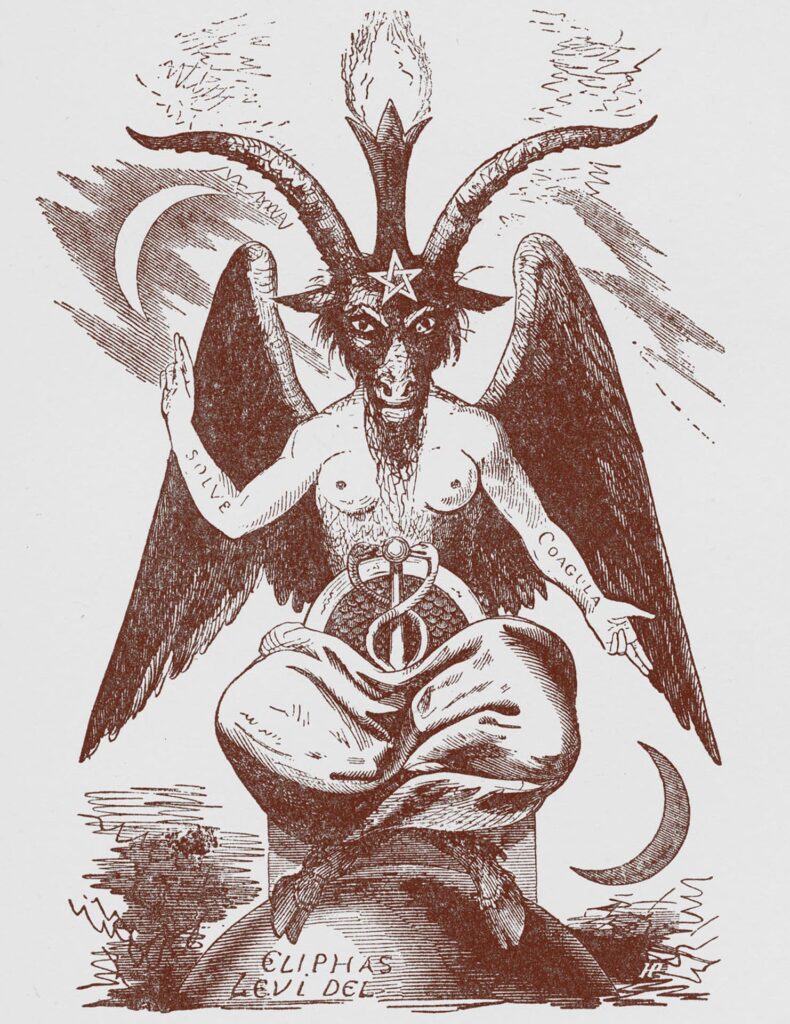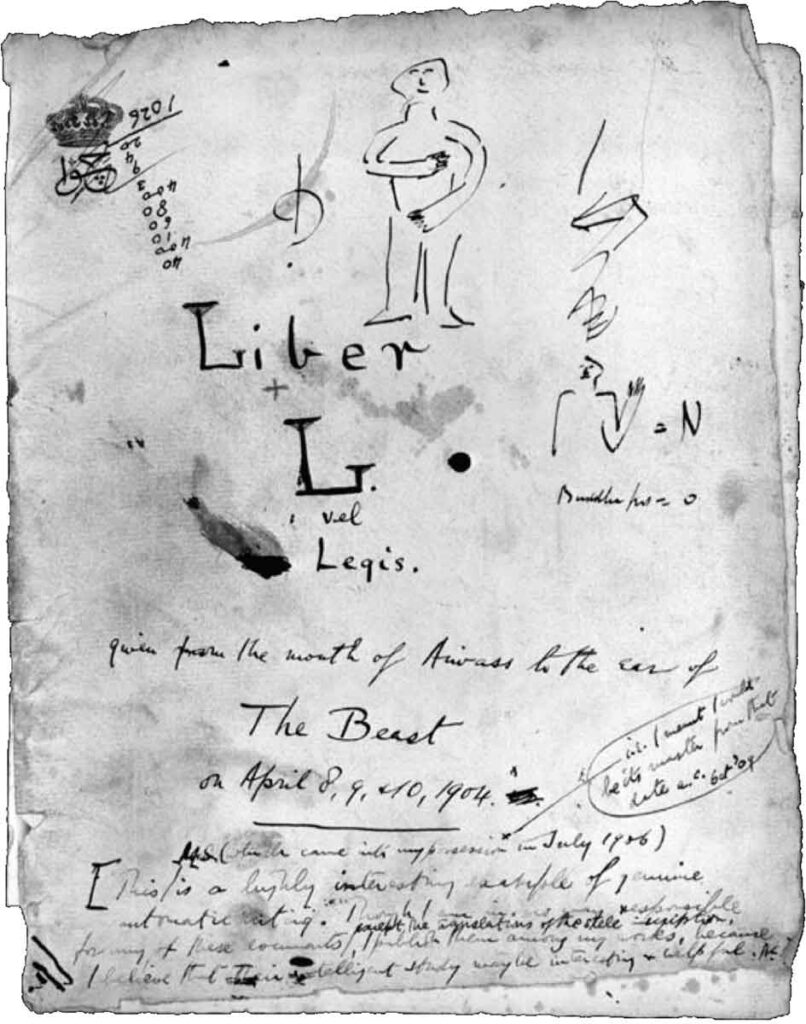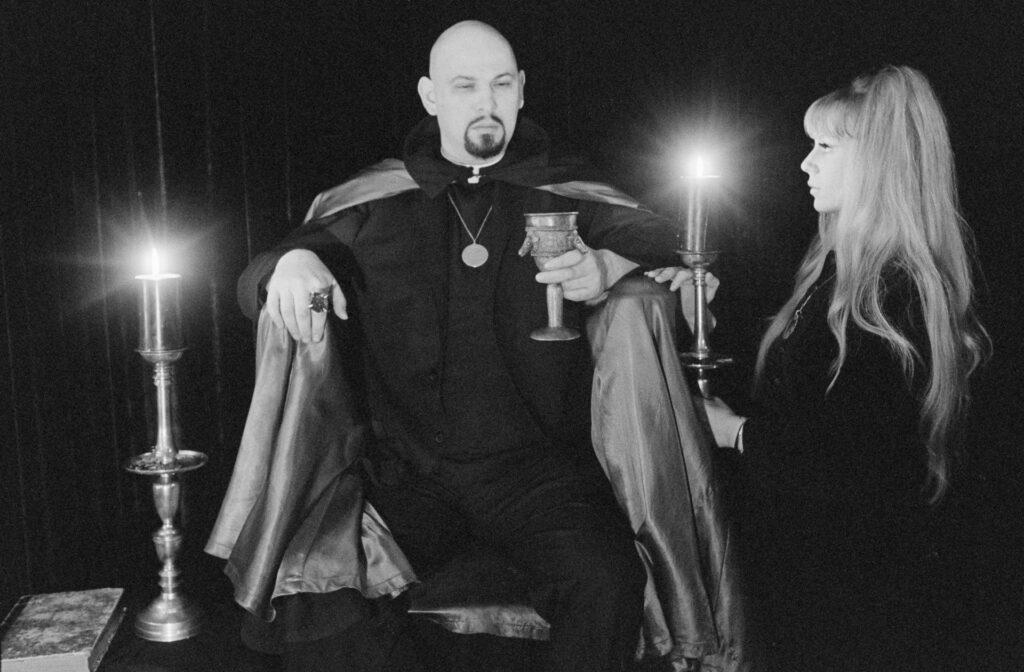The terms “Satanism” and “Satanist” can be traced back to the 1560s — not as a religious designation one ascribed to oneself, but as a way of describing someone with a “satanic disposition.” In Children of Lucifer: The Origins of Modern Religious Satanism, religious historian Ruben van Luijk notes the term latched onto our cultural lexicon during the European Wars of Religion. During this series of conflicts, Christians fought other Christians for well over a century until the Peace of Westphalia in 1648. To valorize their beliefs, Roman Catholics would label Protestants as Satanists. Not that they thought Protestants worshiped the devil, more that their heretical beliefs were align with Satan’s plan for the world.
At times of hardship and despair, peasants would sometimes turn to Satanism as a means to defy the ruling class. Satan is, after all, the ultimate rebel in Christian mythology. With church and state intertwined for much of European history, Satanism was the ultimate anti-establishment party. Other times, upperclassmen would turn to Satanism as a means to break from society’s rules and norms, perhaps wholeheartedly, perhaps for decadence and titillation. But more often than not, Satanism remained an accusation heaped on others. During the Affair of the Poisons, the French people’s imaginations combined anecdotal, yet high-profile, poisoning cases with a fear of witchcraft. The pursuing panic and investigation saw people of all classes denoted as witches and Satanists to be banished, imprisoned, or executed. In his 14th-century poem “Inferno,” Dante captured centuries of Christian belief by portraying Satan as an evil monster. But the Romantics of the 17th century recast him as an admirable and magnetic rebel, an anti-hero defying God’s authoritarianism. John Milton’s epic 1667 poem “Paradise Lost” is the pivotal text for establishing this interpretation in creative works. William Godwin’s 1793 treatise “An Enquiry Concerning Political Justice” later gave Milton’s depiction political legitimacy.

Probably a French misinterpretation of “Muhammed,” Baphomet was the deity the Knights Templar were accused of worshipping in trials in the 14th century. The last half of the 19th century saw a resurgence in the view of Satan as anti-hero. This was thanks to works like Italian poet Giosuè Carducci’s anti-papal “Hymn To Satan” and William Blake’s illustrations for Paradise Lost in 1888.
In his own book The Marriage of Heaven and Hell, Blake presented Satan as a messiah. Around the same time, Theosophical Society founder Madame Blavatsky wrote about Satan as a commendable insurgent offering humans wisdom.
Artists in the Decadent movement like Félicien Rops placed Satanic imagery in paintings, influenced by writers like Baudelaire and Poe. Satan was also employed in writings from socialist leaders like Mikhail Bakunin and Karl Marx.
Polish author Stanisław Przybyszewski wrote two books about Satan in 1897, one fiction and one non-fiction. Przybyszewski’s Satan was an anarchist with a comprehensive philosophy that was similar to modern Satanism. Przybyszewski’s young acolytes called themselves Satan’s Kinder.
it’s still difficult to speak to a coherent, comprehensive Satanism until the 20th century.
Legendary occultist Aleister Crowley viewed Satan symbolically. His 1913 poem “A Hymn to Lucifer” celebrated the Devil as the provider of soul and rebellion to the universe. Crowley’s ideas were influential in Satanism.
One offshoot from Crowley’s crowd was the German group Fraternitas Saturni in 1926. Its founder Gregor A. Gregorius wrote Satanische Magie, which borrowed heavily from the Romantics and adopted Satan within the group’s astrological system. Fraternitas Saturni still exists and Gregorius’ writing has been used in Satanist practice.
The early 20th-century English occultist Aleister Crowley was known in his lifetime as the wickedest man alive, often called “the Beast”. He was accused of being a spy for Nazis because of his beliefs. Many believe that he was misunderstood at the time. Born in England in 1875 into a family of fundamentalist Christians, Crowley’s family was independently wealthy. It was Crowley’s inheritance that allowed him to freely pursue his interest in the occult as a young man, though the money would run out. Crowley later attended Cambridge University where he studied philosophy and then English literature. However, his time was mostly dedicated to other interests such as chess, mountaineering, and publishing poetry. He was a great poet.
In Egypt he studied Islamic mysticism, while his wife Rose seems to have had ecstatic episodes with supernatural entities. On March 20, this would inspire her to take Crowley to a nearby museum where she showed him display number 666—an Egyptian artifact that Crowley would later call the Stele of Revealing. Eventually, in Egypt, Crowley claimed that he was contacted personally by a supernatural entity who provided him with a new sacred text, which formed the basis of his religion, Thelema. Less than a month later, Crowley claimed to have been visited by an entity called Aiwass, who called himself the minister of Hoor-paar-kraat. Crowley said that he could hear the voice of the entity coming to him from behind his left shoulder and that he felt like the entity was in the far corner of the room. Though veiled and ghostly, or rather angelic, Crowley said that Aiwass felt like a tall, dark man in his mid-thirties with the face of a savage king. He spoke to Crowley in English, but with no discernible accent, and was dressed in Persian or Assyrian style. Aiwass visited Crowley at noon for one hour on April 8th, 9th, and 10th. On each of those days, Aiwass revealed a book of knowledge.

Crowley wrote these down and published them in three chapters as The Book of the Law, which became the fundamental text for Thelema. He decided to devote himself full-time to learning magic and returned to London where he joined the occult Hermetic Order of the Golden Dawn to learn ritual magic. Crowley was always adamant that Aiwass had to be an entity separate from himself because he had so much more knowledge than Crowley possessed. He also claimed that Aiwass came to him again in 1907, this time when he was back in England, and recited further texts.

Crowley would also continue to be part of other occult orders and he infused Thelemic ideas into those groups. Most importantly, Theodor Reuss, the German founder of the Ordo Templi Orientis, made Crowley the head of the London branch of his temple. This was when Crowley adopted the magical name Baphomet. Thelema is a classical Greek word that is found in the Greek translation of the Bible. In early Christian writing it is sometimes used to refer to the human will but it is more often used to refer to God’s will.
The main principle of Thelema is that you must find your True Will, which is your unique personal destiny. You must overcome your desires to realize that purpose, which is also called “the Great Work.” The principal teaching of Thelema is: “Do what thou wilt shall be the whole of the Law.” This idea also has its roots in early Christian philosophy. Augustine of Hippo said: “Love and do what thou wilt.” There are two additional core principles in Thelema. The first is that “every man and every woman is a star.” This is a reference to Plato’s statement that humans are composed of the same substance as stars and are neither entirely physical nor entirely spiritual. Therefore, this is a reminder that we are more than our physical bodies. The third principle is: “Love is the law, love under will.” This suggests that our destinies stem from a place of love, but also that the pursuit of love should not come before the pursuit of the Great Work. Traditional magickal practice is not essential to the practice of Thelema, as Crowley considered all intentional acts as acts of magick. But he suggested that magick was a valuable tool for discovering one’s True Will. For those who are magick practitioners, the ultimate goal is to cross the abyss and communicate directly with your daemon so that you can truly embody your True Will. To do this, you must relinquish all ego. Crowley was also, famously, a strong believer in sex magick. What is important is engaging in practices that help you throw off socially instilled inhibitions that block a person from seeing and understanding their True Will. For Crowley, personally, this was sex magick. While he struggled with drug abuse and illness in the later years of his life, still managed to produce the Thoth Tarot Deck.
Satanism is a modern, largely non-theistic religion based on literary, artistic and philosophical interpretations of the central figure of evil. It wasn’t until the 1960s that an official Satanic church was formed by Anton LaVey.
Prior to the 20th Century, Satanism did not exist as a real organized religion but was commonly claimed as real by Christian churches.
The popular image of Satan is a horned, red, demonic human figure with a pointy tail and sometimes hooves. To Christians, sinners are sent to his domain—hell—after death. Hell is described as an underground world dominated by fire and Sadistic demons under Satan’s command.
Satan’s first appearance wasn’t in Christianity. He began as the Zoroastrian Devil figure of Angra Mainyu or Ahriman, which opposed the Zoroastrian creator god and tempted humans. Satan is later portrayed in Jewish Kabbalism, which presents him as a demon who lives in a demonic realm.
The name “Satan” first appeared in the Book of Numbers in the Bible, used as a term describing defiance. The character of Satan is featured in the Book of Job as an accusing angel. In the apocryphal Book of Enoch, written in the first century B.C., Satan is a member of the Watchers, a group of fallen angels.
Later established as a nemesis of Jesus Christ in the New Testament, the final book of the Bible, Revelations, depicts him as the ultimate evil. It’s the Christian figure of Satan that Satanism directly references.

These sessions were mostly discussion-based but on April 30, 1966, the group formalized as the Church of Satan and the meetings became more ritual-based, incorporating theatrics, costuming and music. Lavey became known as the Black Pope. The Church’s early recruiting efforts included the short-lived Topless Witches Revue nightclub show, featuring Susan Atkins, who would later join the Manson Family. Lavey’s Satanic Bible was published in 1969, bringing together Lavey’s personal mix of black magic and occult concepts, secular philosophy and rationalism and anti-Christian ridicule into essays stressing human autonomy and self-determination in the face of an indifferent universe. The Satanic Bible gave the church a national reputation and served as a strong vehicle for its significant growth. Lavey died in 1997.
Ohio barber and part-time spiritual medium Herbert Sloan claimed in 1969 that he started the first Satanist organization, the Our Lady of Endor Coven of the Ophite Cultus Sathanas, in 1948. Sloane described his group as focused on the metaphysical aspects of Satan and offered service, communion and coffee and donuts socializing afterward. To compete with Lavey’s offerings, he added naked women to the meetings.
The Order of Nine Angles formed in England in the 1970s to practice an occult-focused Satanism and the more recent Joy of Satan which wraps UFO conspiracies and anti-Semitism into their Satanism.
As the Church of Satan grew in size, internal rifts developed, leading some members split off to start their own branches.
One expelled church member, Wayne West, formed the First Occultic Church of Man in 1971. Newsletter editor Michael Aquino left to form the Temple of Set in 1975, and plenty others followed. As proof of Satanism’s growth, the U.S. Army included the faith in its manual for chaplains “Religious Requirements and Practices” beginning in 1978.
The next decade brought in newer denominations like the Luciferian Children of Satan, founded by Marco Dimitri in Italy in 1982. Dimitri was convicted of child abuse but was later cleared.
Later Satanic groups include the Order of the Left-Hand Path, a New Zealand group founded in1990 that mixed Satanism with Nietzschean philosophy, and the Satanic Reds. The Satanic Reds formed in 1997 in New York, and combined Satanism with socialism and Lovecraftian concepts—a subgenre of horror fiction.
The Church of Satan weathered the Satanic Panic of the 1980s and ‘90s, with Lavey keeping a calm and low profile despite media attention. But the group faced challenges after Lavey’s death in 1997. Leadership went to Lavey’s partner Blanche Barton after a legal battle with his children. In 2001 Barton appointed author and Church member Peter H. Gilmore as high priest and his wife, church administrator Peggy Nadramia, as high priestess. Gilmore’s controversial claims that Church of Satan members were the only true Satanists led to a new wave of exoduses that saw departing church members creating their own offshoots.
Former Order of the Nine Angles member and heavy metal musician Michael Ford formed the Greater Church of Lucifer in 2013, opening the first public Satanic Temple in Houston two years later. The GCL follows many LaVeyan principles with touches of the occult and has chapters in other countries.
The most successful result of church divisions is The Satanic Temple. It first gained attention in 2013 with a satirical rally against Florida Governor Rick Scott, but grew into a more organized group quickly.
Cofounders Lucien Greaves and Malcolm Jarry characterized the Temple’s creation as a reaction to the Church of Satan’s inability to “manifest itself into a real-world relevant organization.”
Calling itself a non-theistic religion embracing the Devil as a symbolic form of rebellion in the tradition of Milton, the Temple devoted itself to political action focused on the separation of church and state, religious equality and reproductive rights.
The Satanic Temple gained notoriety through two attempts to have a statue of Baphomet legally placed on two state capitol grounds—Oklahoma in 2015 and in Arkansas in 2018—in reaction to government-sanctioned 10 Commandments monuments.
The Temple launched a physical location in Salem, Massachusetts, in 2016 and was recognized as a religion by the U.S. government in 2019, receiving tax-free status. It has grown to include about 20 temples across North America and was the focus of Penny Lane’s acclaimed 2019 documentary, “Hail Satan?” which is credited for giving Satanism its highest profile yet.